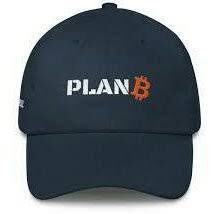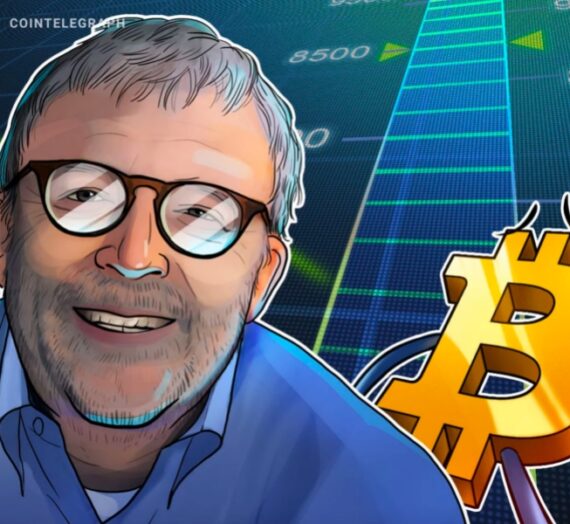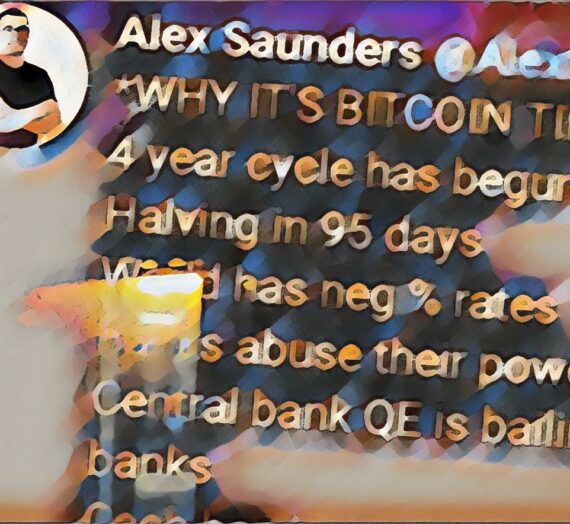PlanB on Bitcoin Math & Value – The Investor’s Podcast, Hosted By Preston Pysh and Stig T. Brodersen (podcast & notes)
Listen to the podcast: We Study Billionaires – The Investor’s Podcast Network – Episode 260 – Bitcoin Math & Value – w/ Plan B
The following is a summary from the podcast provided by podcastnotes.org. Follow along while you listen.
Key Takeaways
- Because of its supply cap of 21 million coins, Bitcoin is the first scarce digital object the world has ever seen
- One can describe the scarcity of a commodity in terms of its Stock-to-Flow (SF) ratio
- Bitcoin currently has an SF ratio of 27
- The SF ratio of all commodities is correlated with their market value
- Gold currently has an SF ratio of 55 and a market value of $10 trillion
- Bitcoin
halving is a significant event (every ~4 years, or 210,000 blocks, the
supply rate of new coins is halved) – this doubles its SF ratio and
increases Bitcoin’s value
- The next halving in May 2020 will increase its value by 8-10x, resulting in an estimated Bitcoin price of $50,000-100,000
- The halving in 2024 will double Bitcoin’s SF ratio again to 100 (something humanity has never seen before), resulting in a Bitcoin price of ~$400k – 1MM
- A futures market settled in Bitcoin will make investors cautious shorting Bitcoin
- If the price goes up, they will need to deliver physical Bitcoin, not just put up more cash
- Bitcoin has a Sharpe ratio above 1, which indicates the average risk is smaller than the average return
- “If you invested just 1% of your portfolio in Bitcoin and let the other 99% do nothing—if you kept it cash, or something similar— that would have outperformed the S&P 500 over a 4-year period for all years in the past 6, 7, or 8 years” – PlanB
- If Bitcoin proves to be inversely correlated with traditional assets during a financial crisis, it’ll make it an undeniable safe-haven asset
Books Mentioned
- In The Bitcoin Standard, author Saifedean Ammous describes the scarcity of a commodity in terms of its Stock-to-Flow (SF) ratio
Resources Mentioned
- The Bitcoin whitepaper, Bitcoin: A Peer-to-Peer Electronic Cash System
- The Stephan Livera and What Bitcoin Did podcasts
- “I never listened to a podcast before Bitcoin—now I listen to a Bitcoin podcast every day in the car” – PlanB
- Hive.one has a list for the most respected Bitcoin authorities (make sure you follow the right people)
Intro
- PlanB (@100trillionUSD) is an anonymous quant known for his statistical work on the Stock-to-Flow analysis of Bitcoin
- Check out PlanB’s article: Modeling Bitcoin’s Value with Scarcity
- Hosts – Preston Pysh (@PrestonPysh) and Stig T. Brodersen (@stig_brodersen)
How PlanB Got Into Bitcoin
- PlanB is currently based in Amsterdam where he works for a multi-billion dollar international fund focused on traditional assets
- He became interested in Bitcoin because of its supply cap of 21 million coins; it’s the first scarce digital object the world has ever seen
- Surely, this digital scarcity has value, but how much? – To find an answer, PlanB decided to apply his expertise to perform solid statistical econometric analysis
Valuing Bitcoin Based on its Stock-to-Flow Ratio
- In The Bitcoin Standard,
author Saifedean Ammous describes the scarcity of a commodity in terms
of its Stock-to-Flow (SF) ratio; if you’re unfamiliar with
Stock-to-Flow:
- The Stock (S): the existing supply of a commodity
- The Flow (F): extra production in the next period
- Stock-to-Flow: How much extra is produced compared to existing stockpiles – (S/F)
- Currently, Bitcoin has a stock of 18,000,000 coins and a yearly flow of 750,000 new coins—an SF ratio of 27
- PlanB discovered the Stock-to-Flow ratio of all commodities is correlated with their market value
- For instance, the SF ratio of gold is 55 and its market value is $10 trillion
- “If
you plot the SF ratio of all commodities against their values, you get a
straight line—it’s actually a power law with super high R2 correlation” – PlanB
- If you’re unfamiliar with R2, it measures the quality of fit for a model on a 0-100% scale
- PlanB applied two models to test the correlation between Bitcoin’s Stock-to-Flow ratio and price:
- The cross-asset model, which resulted in an R2 value of 99.5%
- “It’s amazing; I have never, ever seen that before” – PlanB
- The time series model, which resulted in an R2 value of 95%
- These above values indicate Bitcoin’s price is closely linked to the halving function (discussed below)
- The cross-asset model, which resulted in an R2 value of 99.5%
The Bitcoin Halving Function
- The halving is a significant Bitcoin event: The supply rate of new coins is halved every 210,000 blocks (roughly every ~4 years)
- This halving doubles the Stock-to-Flow ratio and increases Bitcoin’s value
- Currently, Bitcoin has an SF ratio of 27 – the model estimates the price to be little under $10,000 per bitcoin
- The next halving in May 2020 will increase its value by 8-10x, resulting in an estimated Bitcoin price of $50,000-100,000
- The halving during 2024 will double the SF again to 100, resulting in a Bitcoin price of ~$400k – 1MM
- A Stock-to-Flow ratio of 100 is something humanity has never seen before. and is made possible with a decentralized/fixed supply of a digital token
- Preston comments that you can keep mining more gold out of the ground, but with Bitcoin, its absolute scarcity, thus tightening the halving function
- “People underestimate the speed at which this is going; [Bitcoin’s] SF ratio will double to near gold levels after May 2020, which means the market cap of Bitcoin will be in the trillions of dollars—$1-2 trillion, compared to the USD monetary base of $3 trillion. That’s an order of magnitude in the same range. In 2024, [assuming Bitcoin’s] SF ratio doubles to 100, its market cap will be in the $10-20 trillion range, way above the USD, which has all kinds of implications.” – PlanB
Bitcoin’s Path to a $10 Trillion Dollar Market Cap
- Hitting the $10-20 trillion market cap will change what people use as a unit of account—it wouldn’t make sense to price things in dollars anymore
- Bitcoin’s current market cap is only $150 billion, compared to $500 trillion for derivatives and $200 trillion for bond markets
- Many traditional markets (like stock and real estate markets) have a monetary premium beyond the fundamental value they hold; they’ll likely lose that premium to the asset that captures and holds it best (Bitcoin)
The Implications of a Bitcoin Futures Market Settled in Bitcoin
- Derivatives are important—they allow for more liquid
markets that attract bigger institutional investors. Bitcoin has several
big futures markets.
- A futures contract lets you buy and sell bitcoins at a predetermined price at a specified time in the future, settled in the future
- CME Bitcoin futures are settled in cash – you could theoretically sell more than 21 million bitcoins, even if they don’t exist
- Bakkt Bitcoin futures are settled in physically delivered bitcoins – to sell bitcoins, you need to actually have them (and that changes the whole game)
- There can be arbitrage between Bakkt and CME, and investors will be more cautious shorting Bitcoin
- If the price goes up, they’ll need to deliver those bitcoins—it’s not a matter of putting up more fiat
The Significance of the Sharpe Ratio When Investing in Bitcoin
- Bitcoin has a Sharpe ratio above 1, which indicates the average risk is smaller than the average return; this is hard to see in assets
- Bitcoin’s average return is above 200% per year, while the worst loss is 80%
- (The Sharpe ratio is a measure of risk-adjusted return)
- Using the Kelly Criterion, just like in poker, you size your bet depending on your odds
- “If you invested just 1% of your portfolio in Bitcoin and let the other 99% do nothing—if you kept it cash, or something similar— that would have outperformed the S&P 500 over a 4-year period for all years in the past 6, 7, or 8 years” – PlanB
- Ray Dalio explains how his investing revolves around two principles:
- Finding something with a very high Sharpe ratio
- Mixing it with 10-15 uncorrelated positions that also have high Sharpe ratios
Bitcoin Has Yet to Be Tested By a Financial Crisis
- Bitcoin was invented in 2009 as a response to the 2008 financial crisis
- Inverted
yield curves and other measures are pointing to an incoming
recession—this will be the time to test Bitcoin for negative correlation
with other assets
- If Bitcoin proves to be inversely correlated with traditional assets during a financial crisis, it’ll make it an undeniable safe-haven asset
- “The negative interest on $17 trillion dollars worth of bonds together with quantitative easing is the reason I’m in Bitcoin” – PlanB
- PlanB mentions the IMF report proposing deep negative interest rates (-5 to -10%)
- Negative-yielding bonds mean that buyers holding the securities to maturity are guaranteed to make a loss
- Preston explains that making a profit on a negative-yielding bond means buyers expect the interest rates to go even lower; the only way to make money is by finding a greater fool willing to take an even bigger loss—it’s the definition of the greater fools theory of investing (a Ponzi scheme)
- Most investors are starting to see the unsustainability of this and more will hedge against it with Bitcoin
Hyperinflation & Bitcoin:
- The 1920s collapse of the German Mark against gold is the most famous example of hyperinflation – PlanB published a chart comparing it with Bitcoin’s USD price
- A coalition of smaller countries is most likely to adopt Bitcoin
- The U.S. has too much to lose by giving up its reserve currency status; this is similar to Germany, who has too many exports to make the jump
- Bitcoin is the solution in the Triffin dilemma, but only if everyone works together
How should investors educate themselves about Bitcoin?
- (With the resources mentioned above)
- PlanB is amazed by
the level of misunderstanding in the traditional investment field – this
reminds him of the Nobel Prize-winning Black-Scholes Model invented in 1973 for pricing options
- The model was in public for 10 years but wasn’t understood or exploited – it’ll probably be the same with the Stock-to-Flow model
- Why did Satoshi
leave? – If you research and come to know the answer to this question,
you’ll protect yourself against a lot of scammers, misunderstanding, and
misinformation.
- “Why is it important NOT to have a leader—no CEO, no corporation, no government, no pre-mine? If you understand why that is, and why you only need a peer-to-peer network governed by a mathematical protocol and some energy to protect it, you know the answers to a lot of things in Bitcoin.” – PlanB
Ask The Investors: Should I invest in China?
- Stig explais it’s important to not overestimate the effect of the rise of China on US stock investors
- Stig and Preston agree you could get exposure by buying a Chinese ETF tracking the stock index. But keep in mind:
- The risk of investing in a country with very different regulations from the west
- It can have expensive management fees and can have other risks
- If you’re feeling adventurous and want to focus on individual companies, focus on three things:
- Find a company that originated in China
- Look for companies that have a fairly large market cap with room to grow
- Look for companies that have government leadership entrenched within them, such as Tencent and Alibaba
- Stig personally owns Alibaba stock as a bet on e-commerce in China in general, but he doesn’t recommend investing for China for its own sake
- Preston doesn’t personally have any investments in China.
Special thanks to Podcast Notes (see their original podcast transcript)




